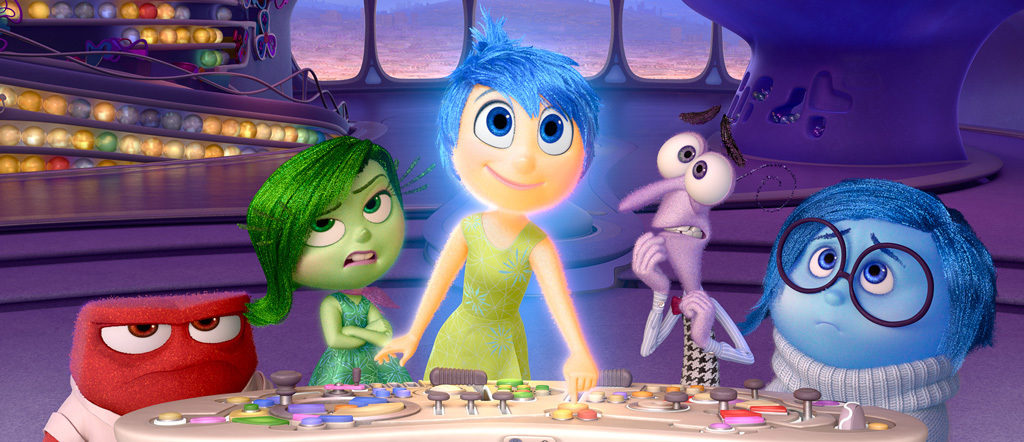Summer Movie Series
Inside Out (2015)
Rated PG

Disney/Pixar
Known for taking children’s emotions seriously, Pixar’s latest film nevertheless surprised me with its complexity and daring. It’s not that Inside Out doesn’t have the Pixar touch: it’s funny and loaded with action and superb visuals. It’s also one of the studio’s most inventive, plot-wise, rivaling Monster Inc., Ratatouille and Up in that respect. But it carries the ambitions of Pixar’s more adult-leaning efforts, The Incredibles and Wall-E. It takes an adult to see what Pixar’s attempting here, but a child to feel it.
 By now you’ve seen the previews, right? You’ve been introduced to Riley, the 11-year-old girl whose emotions are personified by cutely rendered and directly named creations: Joy (Amy Poehler), Sadness (Phyllis Smith), Disgust (Mindy Kaling), Anger (Lewis Black) and Fear (Bill Hader). These beings stand around a console in the middle of Riley’s mind and take turns guiding her through her days. In an inventive system, the team captures Riley’s emotions in glowing spheres, which are organized according to importance and shipped off, via vacuum tubes and trains, to be stored until they are reused, forgotten or discarded.
By now you’ve seen the previews, right? You’ve been introduced to Riley, the 11-year-old girl whose emotions are personified by cutely rendered and directly named creations: Joy (Amy Poehler), Sadness (Phyllis Smith), Disgust (Mindy Kaling), Anger (Lewis Black) and Fear (Bill Hader). These beings stand around a console in the middle of Riley’s mind and take turns guiding her through her days. In an inventive system, the team captures Riley’s emotions in glowing spheres, which are organized according to importance and shipped off, via vacuum tubes and trains, to be stored until they are reused, forgotten or discarded.
The pixie Joy has big blue eyes and a sun-like aura. Anger, in his tweed pants and loosened necktie is forever moments away from literally blowing his top. Sadness, who in many ways becomes the heart of the film, mopes about with her asymmetrical haircut and turtleneck sweater. Disgust, who the film does the least with, has fabulous lashes, perfect hair and a high-maintenance disposition. The insect-like Fear is mostly over-the-top manic, but he does get some big laughs.
Like old pros Riley’s color-coded emotions know when each is up at bat. She needs some toughness to excel on the hockey ice, here comes Anger to juice her up. She needs her spirits lifted after a bad situation, there’s Joy. About Joy: she’s clearly the leader of the pack, whose abundance of, well, joy keeps Riley buoyed along rippling currents of adolescence. That’s the way it’s supposed to be, isn’t it? A child leading a joyous existence? But what happens when joy isn’t suitable as a coping mechanism? Realistically, can we be happy all the time, in every situation?
Riley’s life faces a seismic shift when her family relocates to the West Coast. New home, new school, new friends. Now the animated kids’ film begins to deepen as life’s realities reshape emotions and self-value.
I can think of a half-dozen ways this movie could have taken easier routes through this material, like the tried-and-true Pixar formula of one part kid mixed with one part adult mixed with one part critic-impressing subtext. Instead it relies on honest emotions and not half measures to pull us to its conclusion.
The psychological and neurological underpinnings of the film seem seriously considered. We’re dealing with short-time memories, long-term ones stored as keepsakes, and essential core memories that are critical to Riley’s fundamental outlook on life. There are long-standing islands harboring the girl’s personality: one formed from love of family, one formed for zany diversions, still another based around her love of hockey. (It’s brutal to see those islands crumble under trauma faced by Riley.) There’s long-forgotten wastelands of defunct memories (and discarded imaginary friends) and emotions that are haunting. Not to mention visits to towns that house Riley’s abstract thinking, dreams, imagination and fears. The team manufacturing her nightly dreams as if they were film productions is particularly inspired.
The plot involves the upheaval of those core memories as Joy and Sadness are accidently launched away from headquarters and must journey home before Riley’s life implodes from the lack of Joy and the internal conflict from the remaining emotions—at the very time in her life when she needs them at their best. The film gains power as we cut back and forth between the exciting mission inside Riley’s head and the blunt emotional consequences in her real world. It’s one thing to see the emotions muck up their roles and tumble through various caverns in their child’s mind; it’s another to see young Riley slip into depression and emotional confusion and anger she can’t articulate to her parents. With Joy away from headquarters, even Riley’s love of hockey and the self-esteem it built slips away in one heartbreaking scene.
At one point during the film, my daughter began to cry and I wondered if the material was too much for her. As I watched her, I realized she was right there fraught with Riley, and ultimately, like Riley, my daughter worked her way through her emotions. Somehow the film makes visually manifest abstract ideas of how we can laugh and cry through the same experience—and how each of those emotions are essential.
It’s not the greatest animated film ever made, but Pixar could have rested on its laurels and delivered a good, fun movie with this material. Instead, in pushing to make one of its most ambitious films yet, Pixar sinks the slap shot.

More Summer Movie Reviews:
| Marvin Brown’s Movie Review Archive








